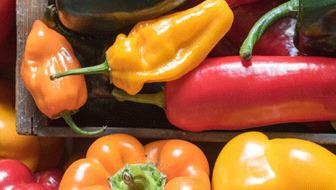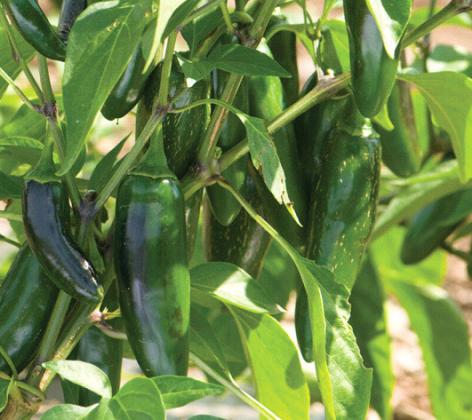Tomatoes are the most popular vegetable grown in home gardens. In New Mexico, we have a love affair with the chili pepper that competes with tomatoes for prominence. If you make salsa, growing tomatoes and chilies are a natural combination because they mature at the same time. Also, both are in the same plant family, Solanaceae. This is important to know when you rotate your plants in the garden. Select other families like legumes or squash as alternate years.
Growing in the “High West Desert” of New Mexico is not the same as growing in Hatch, NM. Hatch has a much longer growing season, two months (60 days) longer. But the thing I notice most is the warm evenings decrease as the altitude increases. Chili can be grown but we have to have to alter our growing strategy. Chilies and all peppers need a long growing season, warm days and nights, and lots of sun. We can get around this by buying varieties with a shorter growing time to harvest and then starting them inside two months before our last frostfree day or buying plants. The seeds have to be grown in warm soil. Inside, use a germination mat or very warm location (86 degrees F.). This allows them to sprout in one week instead of three weeks. Every week is important in growing chili.
When the soil has warmed up in June, move the plants outside and place them in a sunny location about 12 inches apart. If we have another year with cool weather lasting until mid-June, the use of row covers, black plastic mulch, or “wall of water” will help them survive until weather warms. The plants need soil with good drainage and nutrients so add compost or aged manure before planting. Phosphorus, calcium, and magnesium are nutrients the chili plants need to produce fruits. When plants start flowering cut down on nitrogen in your fertilizer.
If you have trouble getting enough chilies to set on your plants, several things could be the cause. (1) Temperature could be too cold or too hot. Plants will not produce flowers or set fruit until the temperature moderates. We certainly saw this last year. (2) Peppers are self-fertilizing like their cousins, the tomatoes. Movement from wind or insects to get the pollen to the pistil(stigma) helps as does tapping the plant or vibrating it with an electric toothbrush. (3) Grow your plants on the dry side. I am used to watering daily in my sandy soil. Allowing the plants to dry to the point of light droop before watering stimulates more flowering. (4) I found only one source that suggested crowding the pepper plants as a way to increase fruiting. It may be something to try.
I have lived in New Mexico for 30 years and hate to admit I have rarely grown chili peppers. First there are so many kinds. How do you choose a couple of chilies to grow from the twenty plus kinds and hundreds of names? I needed to demystify the world of chilies.
Chili categories: Capsicum annuum is the main group grown in NM but there are subgroups.
There is a large category of “Sweet” chilies. Most of them are 0 to 50 SKUs in heat. They are Bell Peppers, Carmen Sweets, Banana Peppers, Pepperoncini, Shishito, and Pimento. They have many culinary uses: fresh, grilled, stuffed, pickled, & others. A second category is Ornamental chilies. They are not only beautiful in flower gardens and landscaping but are edible as well.
The rest of the chilies are the ones we plant in our gardens and see at farmer’s markets and grocery stores: The Hot Chilies! It is helpful to compare types by the heat scale.
The heat scale was developed by Wilbur Scoville and it is used to determine how hot a chili is. An interesting fact is that one plant can produce chili pods with different SKUs. A Bell Pepper is 0 SKUs on the Scoville Heat Unit scale and the hottest chili, Carolina Reaper, is 2,000,000 SKUs!
• Anaheim/Numex – The one associated with chili roasting, and versatility of use = 1,000 to 5,000 SKU.
• Ancho/Poblano – Used for stuffing or in stew = 1,000 to 2,000 SKU
• Jalapeno – Used on a daily basis in almost anything cooked or raw = 2,000 to 5,000 SKUs
• Serrano – Good for salsa and sauces = 10,000 to 25,000 SKUs
• Cayenne/Tai/Tabasco – Thin walled, used powdered = 30,000 to 50,000 SKUs
• Habanero – Used in Caribbean jerk and other foods = 150,000 to 350,000 SKUs
• Carolina Reaper / Ghost Pepper = For those who like extreme heat, used powered or experiment = 1,000,000 to 2,000,000 SKUs What ever your heat tolerance is for a chili, there is a type for your need, and growing your own chili can bring you the satisfaction of producing something great to eat.
Edith Iwan is a Cibola-McKinley County Master Gardener who lives and works in Thoreau. As a Master Gardener she assists the County Cooperative Extension Service in providing accurate, research- based gardening information to county residents. If you have any gardening questions, please call the NMSU Cibola County Extension at 505-287-9266 or NMSU McKinley County Extension at 505-863-3432


